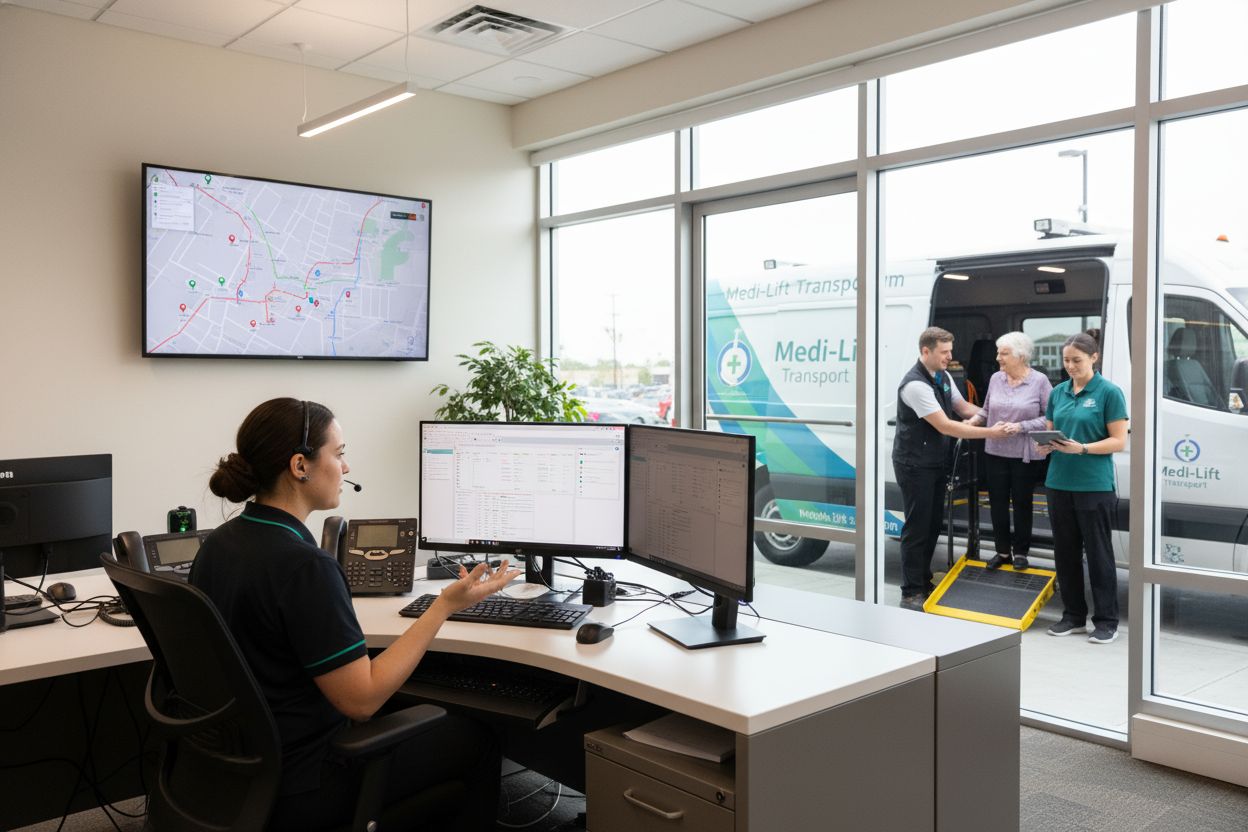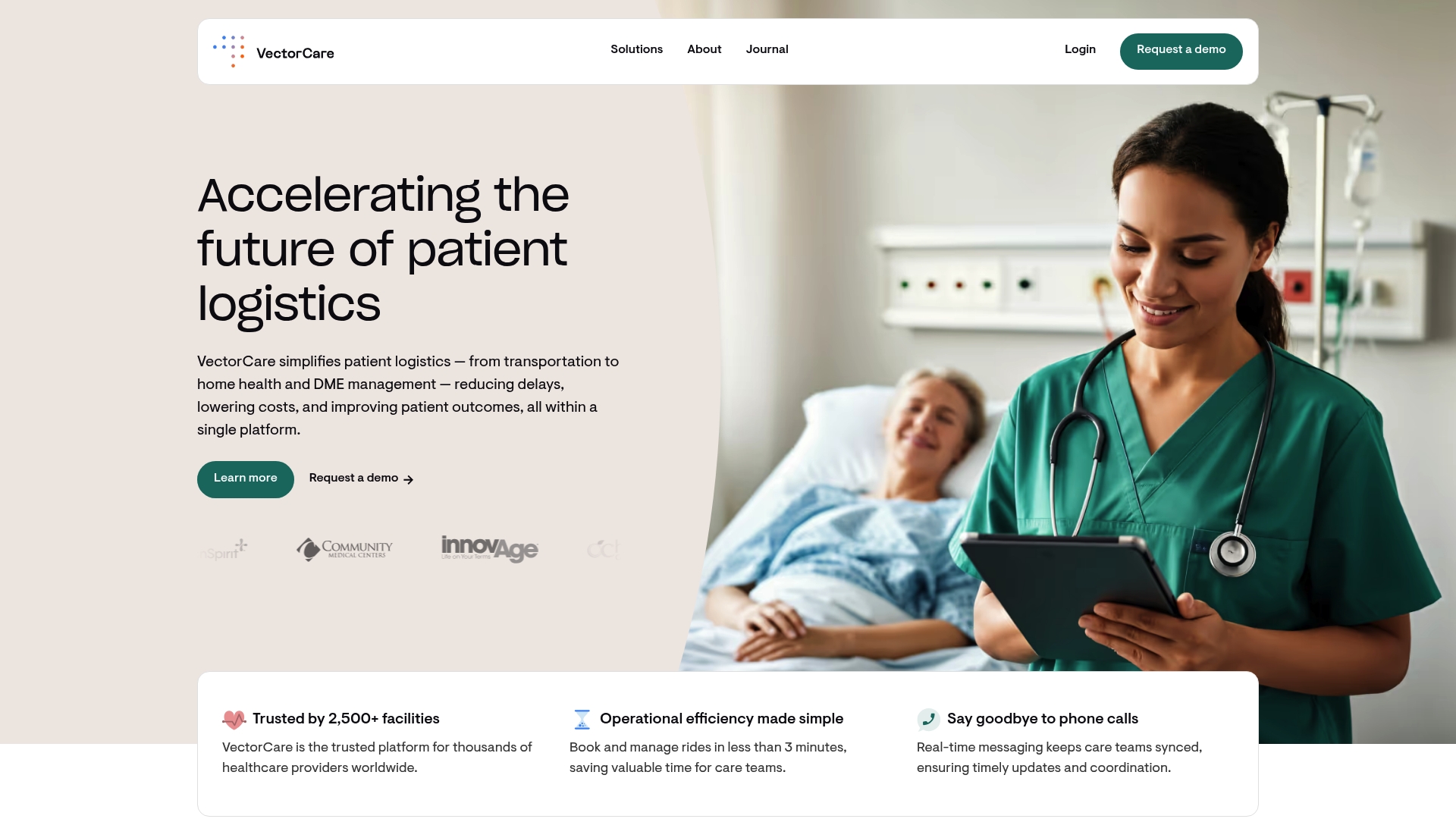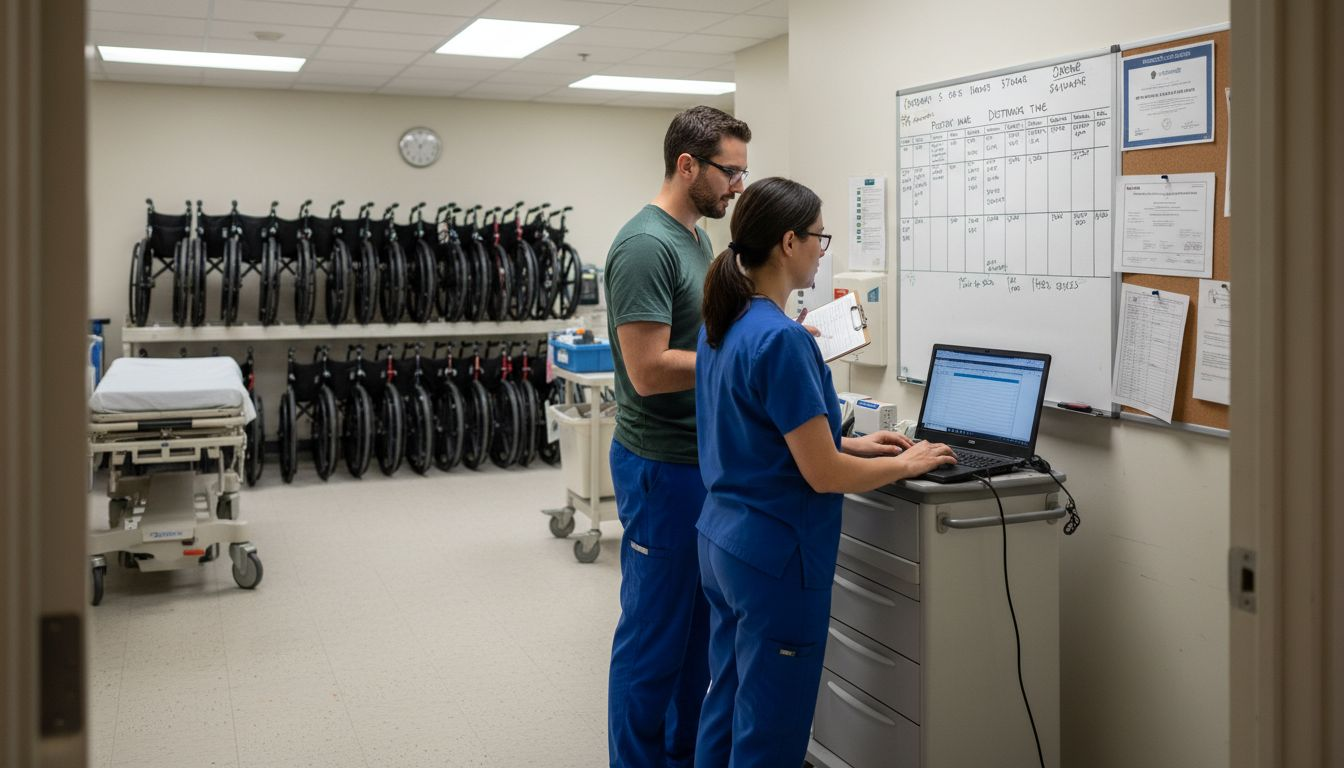7 Essential Digital Strategies for NEMT Providers

Nearly 70 percent of Non Emergency Medical Transportation providers are now adopting technology solutions to improve service and reduce costs. As patient expectations rise and regulations tighten, the need for smarter, faster, and more secure transport systems has never been greater. Discover how digital advancements like automated scheduling, real-time dispatch updates, and data insights are helping providers deliver better outcomes, faster rides, and safer experiences for patients and staff alike.
Quick Summary
| Takeaway | Explanation |
|---|---|
| 1. Automate scheduling to save time. | Automated tools can reduce scheduling time by 2-3 hours daily for NEMT providers. |
| 2. Use real-time dispatch updates for efficiency. | Implementing real-time updates enhances communication, reduces response times, and optimizes resource allocation. |
| 3. Optimize route planning with AI. | AI-powered routing can improve efficiency by up to 40%, significantly reducing operational costs and driving time. |
| 4. Ensure secure communication channels. | Implement HIPAA-compliant communication systems to protect patient data and facilitate real-time collaboration. |
| 5. Leverage data insights for operational improvement. | Utilize advanced analytics platforms to gain insights on fleet performance and patient transportation efficiency for better decision-making. |
Table of Contents
- Embracing Automated Scheduling Tools
- Leveraging Real-Time Dispatch Updates
- Optimizing Route Planning For Efficiency
- Integrating Secure Communication Channels
- Implementing Vendor Management Solutions
- Utilizing Data Insights For Performance
- Ensuring Compliance And Scalability
1. Embracing Automated Scheduling Tools
Automatic scheduling tools represent a transformative solution for Non Emergency Medical Transportation (NEMT) providers seeking to streamline their operational workflows. These intelligent platforms eliminate the complexity and time consuming manual coordination that traditionally bogs down transportation logistics.
The core power of automated scheduling lies in its ability to dynamically match patient transportation needs with precise provider capabilities. According to research from Understanding Scheduling Software for Healthcare Providers, smart algorithms can dramatically reduce administrative overhead while improving overall service efficiency.
Key Benefits of Automated Scheduling Include:
- Instant ride matching based on vehicle type and patient requirements
- Reduced administrative errors
- Real time visibility across transportation networks
- Accelerated trip coordination processes
By implementing automated scheduling platforms, NEMT providers can save critical time and resources. Research from Ryde Central indicates that such platforms can automatically assign rides by considering multiple complex factors simultaneously. These factors include provider availability, specific vehicle requirements, geographic distance, and individual patient needs.
Practical implementation starts with selecting a robust scheduling platform that offers seamless integration with existing systems. Look for solutions that provide:
- Intuitive user interfaces
- Comprehensive reporting capabilities
- Flexible configuration options
- Strong data security protocols
The most effective automated scheduling tools transform what was once a manual administrative task into a streamlined digital workflow. Providers can expect to reduce scheduling time by 2 to 3 hours daily while simultaneously improving overall transportation coordination precision.
Transitioning to an automated scheduling system represents more than a technological upgrade. It is a strategic investment in operational excellence that directly impacts patient care quality and organizational efficiency.
2. Leveraging Real-Time Dispatch Updates
Real-time dispatch updates have become a critical technological advancement for Non Emergency Medical Transportation (NEMT) providers seeking to enhance operational efficiency and patient care. These dynamic communication systems provide immediate visibility into transportation logistics, enabling rapid response and seamless coordination across complex healthcare networks.
The fundamental power of real-time dispatch updates lies in their ability to transform traditional communication models. By integrating advanced digital platforms, NEMT providers can now track vehicle locations, monitor patient pickups, and adjust routes instantaneously. 5 Reasons to Improve Healthcare Dispatching demonstrates how these technologies fundamentally reshape patient transportation management.
Key Components of Effective Real-Time Dispatch Systems:
- GPS tracking for precise vehicle location
- Instant communication channels
- Automated status notifications
- Dynamic route optimization
Implementing real-time dispatch updates requires strategic technological integration. Providers must select platforms that offer comprehensive features while maintaining user friendly interfaces. The goal is creating a system that provides actionable information without overwhelming dispatchers or drivers.
Practical implementation involves selecting software that offers:
- Seamless mobile app integration
- Robust reporting capabilities
- Secure communication protocols
- Customizable alert mechanisms
By embracing real-time dispatch technologies, NEMT providers can significantly reduce response times, improve patient experiences, and optimize resource allocation. These systems enable instantaneous decision making that was previously impossible with traditional communication methods.
The digital transformation of dispatch operations represents more than a technological upgrade. It is a strategic approach to delivering more responsive, transparent, and efficient patient transportation services that prioritize both operational excellence and patient care.
3. Optimizing Route Planning for Efficiency
Route planning represents a critical strategic lever for Non Emergency Medical Transportation (NEMT) providers seeking to maximize operational performance and patient service quality. Advanced route optimization technologies have transformed what was once a complex manual process into a sophisticated digital strategy for reducing costs and improving transportation efficiency.
Artificial Intelligence has become a game changing technology in route planning. According to research from RouteOps, AI-powered routing can optimize hundreds of routes in seconds, delivering up to 40% efficiency gains and saving providers over three hours of administrative time daily. Maximizing Efficiencies Through Better Patient Logistics highlights how strategic route planning directly impacts operational excellence.
Key Optimization Strategies Include:
- Minimize total travel distance
- Reduce unnecessary vehicle miles
- Match trips with appropriate vehicle capacity
- Enable real-time route adjustments
Implementing intelligent route planning requires selecting sophisticated software capable of complex computational analysis. Advanced systems like AngelTrack leverage Vertex AI routing engines that can evaluate millions of potential route configurations while considering multiple critical factors.
Practical implementation involves:
- Selecting AI-powered routing platforms
- Integrating live GPS tracking
- Configuring vehicle-specific constraints
- Establishing dynamic routing protocols
The most effective route optimization solutions can reduce deadhead miles by 5 to 15 percent. These technologies not only improve financial efficiency but also enhance patient experience by providing more reliable and timely transportation services.
Route planning is no longer just about getting from point A to point B. It is a strategic approach to resource allocation that directly impacts patient care, operational costs, and overall organizational performance.
4. Integrating Secure Communication Channels
Secure communication represents a critical infrastructure component for Non Emergency Medical Transportation (NEMT) providers navigating complex patient logistics and regulatory environments. Modern digital platforms have transformed traditional communication methods by providing robust, HIPAA compliant channels that protect sensitive patient information while enabling real time collaboration.
The landscape of healthcare communication has dramatically shifted towards mobile integrated solutions that prioritize both security and efficiency. According to research from NEMT Cloud Dispatch, iOS and Android driver applications now offer instant secure communication features that allow seamless interactions between drivers and dispatchers while maintaining stringent privacy standards. Home Health Logistics Made Easy underscores the critical importance of these integrated communication strategies.
Essential Secure Communication Features:
- End to end encryption
- HIPAA compliant messaging
- Real time information exchange
- Secure user authentication
Successful implementation requires selecting platforms that offer comprehensive security protocols. Healthcare providers must prioritize solutions that not only facilitate communication but also protect patient data through advanced technological safeguards.
Practical steps for integrating secure communication include:
- Evaluating platform security certifications
- Training staff on secure communication protocols
- Implementing multi factor authentication
- Regular security audits and updates
The most effective communication channels transform traditional fragmented interactions into streamlined digital workflows. By leveraging mobile technologies with robust security features, NEMT providers can enhance operational efficiency while maintaining the highest standards of patient confidentiality.
Secure communication is no longer an optional enhancement but a fundamental requirement in modern patient transportation services. It represents the intersection of technological innovation and professional responsibility.
5. Implementing Vendor Management Solutions
Vendor management solutions represent a strategic approach for Non Emergency Medical Transportation (NEMT) providers to streamline complex operational networks and optimize third party service coordination. These digital platforms transform traditional vendor interactions into sophisticated, data driven management ecosystems that enhance transparency, efficiency, and scalability.
Modern vendor management systems offer web based tools that revolutionize how healthcare transportation providers procure and manage external services. Understanding Vendor Management Challenges in Healthcare highlights the critical importance of developing robust vendor coordination strategies that go beyond simple transactional relationships.
Core Vendor Management Capabilities:
- Centralized vendor performance tracking
- Automated contract management
- Consolidated billing processes
- Customizable vendor selection rules
- Real time reporting and analytics
Research from Ryde Central demonstrates how advanced platforms can support multi vendor management by creating customizable assignment rules that enable structured vendor selection. These systems allow NEMT providers to coordinate rides across multiple transport providers while maintaining high standards of service quality and operational flexibility.
Successful implementation requires a strategic approach that includes:
- Conducting comprehensive vendor assessments
- Establishing clear performance metrics
- Developing standardized evaluation protocols
- Implementing continuous feedback mechanisms
A vendor management system provides significant operational advantages by simplifying complex procurement processes. By consolidating billing, enhancing reporting capabilities, and mitigating vendor related risks, these digital solutions enable NEMT providers to focus on their core mission of patient transportation.
The future of healthcare logistics lies in intelligent, integrated vendor management strategies that transform external relationships from transactional interactions into collaborative partnerships.
6. Utilizing Data Insights for Performance
Data insights have emerged as a transformative force in Non Emergency Medical Transportation (NEMT) operations, providing unprecedented visibility into complex transportation ecosystems. Modern analytics platforms enable providers to move beyond traditional reactive management towards proactive strategic decision making powered by real-time intelligence.
Advanced data dashboards represent the new frontier of operational performance management. Healthcare Data Insights for Providers and Agencies 2025 emphasizes how sophisticated analytics can fundamentally reshape organizational efficiency. According to research from NEMT Platform, these systems now deliver comprehensive insights including real-time location tracking, precise mileage calculations, and nuanced driver safety metrics.
Critical Performance Insight Categories:
- Fleet utilization rates
- Driver performance metrics
- Patient transportation efficiency
- Operational cost analysis
- Compliance verification
Successful data insight strategies require robust technological infrastructure that transforms raw information into actionable intelligence. Providers like Prehos demonstrate how situational awareness dashboards can integrate multiple data streams including GPS navigation, automated reporting, and compliance tracking.
Practical implementation involves:
- Selecting comprehensive analytics platforms
- Establishing clear performance benchmarks
- Creating regular performance review protocols
- Training staff on data interpretation
- Developing continuous improvement frameworks
The most effective data insight strategies go beyond simple metric tracking. They create a holistic view of organizational performance that enables predictive analysis, identifies improvement opportunities, and supports strategic planning.
In the evolving landscape of patient transportation, data is no longer just information. It is the strategic language through which high performing NEMT providers communicate organizational potential and drive continuous improvement.
7. Ensuring Compliance and Scalability
CompliancE and scalability represent the twin pillars of sustainable digital transformation for Non Emergency Medical Transportation (NEMT) providers. Modern healthcare logistics demand technological solutions that can seamlessly adapt to changing operational requirements while maintaining rigorous regulatory standards.
Cloud based technologies have emerged as the primary mechanism for achieving simultaneous compliance and organizational growth. What Is Healthcare Compliance? Essential Guide for 2025 emphasizes the critical importance of building flexible technological infrastructures that can support complex regulatory environments.
Essential Compliance and Scalability Components:
- HIPAA compliant data management
- Audit ready documentation systems
- Flexible technological architectures
- Secure claims processing capabilities
- Adaptable operational frameworks
Research from AngelTrack demonstrates how advanced scheduling software can maintain comprehensive HIPAA compliance while simultaneously supporting organizational growth. These platforms enable providers to transition from local operations to regional fleets without compromising operational efficiency or regulatory adherence.
Practical implementation strategies include:
- Selecting cloud native software platforms
- Developing comprehensive compliance training programs
- Implementing robust documentation protocols
- Creating scalable operational workflows
- Establishing continuous monitoring systems
The most sophisticated NEMT platforms now offer unprecedented operational flexibility. According to NEMT Platform research, providers can now scale from 5 to 500 vehicles without adding significant administrative headcount. This represents a fundamental shift in how healthcare transportation organizations conceptualize growth and operational efficiency.
Compliance is no longer a constraint but a strategic enabler of organizational potential. The most successful NEMT providers will be those who view regulatory requirements as opportunities for innovation and operational excellence.
Below is a comprehensive table summarizing the key technological advancements and strategies discussed in the article for Non Emergency Medical Transportation (NEMT) providers.
| Technology/Strategy | Key Features | Implementation Steps | Benefits/Outcomes |
|---|---|---|---|
| Automated Scheduling | Instant ride matching, Reduced errors, Real-time visibility | Select robust platform with integration, Configure custom settings | Saves time, Improves efficiency, Enhances care |
| Real-Time Dispatch Updates | GPS tracking, Instant communication, Dynamic route optimization | Implement integrated platform, Use secure protocols | Reduces response times, Optimizes resource allocation |
| Route Planning | AI optimization, Real-time adjustments, Distance minimization | Choose AI-powered platform, Configure constraints, Establish protocols | Increases efficiency, Saves time, Enhances reliability |
| Secure Communication Channels | End-to-end encryption, HIPAA compliance, Real-time exchange | Select secure platform, Train staff, Use multi-factor authentication | Protects patient data, Improves workflow |
| Vendor Management Solutions | Centralized tracking, Automated contracts, Real-time reporting | Conduct assessments, Establish metrics, Implement feedback mechanisms | Simplifies procurement, Enhances coordination |
| Data Insights | Fleet utilization, Performance metrics, Cost analysis | Use analytics platforms, Establish benchmarks, Train staff | Enables strategic decision-making, Identifies improvements |
| Compliance and Scalability | HIPAA compliance, Audit-ready systems, Flexible architectures | Use cloud platforms, Develop training, Establish workflows | Supports growth, Ensures regulatory adherence |
Unlock Real Efficiency in NEMT Operations—See the VectorCare Difference
If you are frustrated with manual scheduling, communication delays, or costly mistakes in your transportation workflows, you are not alone. The article “7 Essential Digital Strategies for NEMT Providers” highlights how crucial it is to automate scheduling, leverage real-time dispatch, and gain valuable data insights to reduce administrative burdens and deliver better patient experiences. VectorCare’s comprehensive digital platform was designed specifically to address these pain points. You will discover integrated capabilities for scheduling optimization, vendor management, secure communication, and actionable data insights, all engineered to help NEMT providers like you save time, cut costs, and ensure compliance.

Are you ready to transform the way your team manages patient logistics? Explore how VectorCare’s solutions can help you eliminate inefficiency and keep patient care at the center. Take action now by visiting VectorCare’s platform overview. See how providers are embracing real-time updates and scalable automation to stay ahead in the evolving NEMT industry.
Frequently Asked Questions
What are the key benefits of automated scheduling tools for NEMT providers?
Automated scheduling tools streamline the process of coordinating patient transportation, reducing administrative errors and improving efficiency. To harness these benefits, implement an automated scheduling platform that reduces scheduling time by 2 to 3 hours daily.
How can real-time dispatch updates improve patient transportation services?
Real-time dispatch updates enhance visibility into vehicle locations and patient pickups, allowing for quicker response times. Begin by integrating GPS tracking and instant communication channels to ensure seamless coordination and improve patient experiences.
What strategies can NEMT providers use for effective route planning?
Effective route planning strategies include minimizing travel distance, reducing vehicle miles, and optimizing trip vehicles. Utilize AI-powered routing technologies that can analyze multiple route options quickly, potentially improving efficiency by up to 40%.
How can I ensure compliance when implementing new digital technologies for my NEMT service?
To ensure compliance, prioritize choosing cloud-based technology solutions that meet HIPAA compliance and facilitate secure data management. Start by developing comprehensive training programs for staff on compliance protocols and implementing rigorous documentation practices.
What features should I look for in a vendor management solution for NEMT operations?
Key features of an effective vendor management solution include centralized performance tracking, automated contract management, and customizable vendor selection rules. Evaluate potential systems based on these criteria to enhance your operational efficiency and service quality.
How can data insights drive performance improvement in NEMT services?
Utilizing data insights can uncover critical performance metrics like fleet utilization and patient transportation efficiency, leading to proactive decision-making. Set up comprehensive analytics systems to monitor performance continuously and identify opportunities for improvement, focusing on key metrics regularly.



